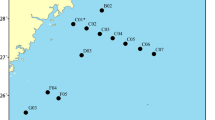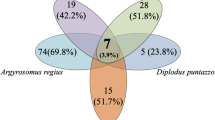Abstract
Bluegill (Lepomis macrochirus) in Lake Biwa, Japan, feed on benthic invertebrates (benthivorous type), aquatic plants (herbivorous type), and zooplankton (planktivorous type). To evaluate the effect of food on intestinal bacterial microbiota, we characterized and compared the intestinal microbiota of these three types of bluegill in terms of community-level physiological profile (CLPP) and genetic structure. The CLPP was analyzed using Biolog MicroPlates (Biolog, Inc., Hayward, CA, USA), and multivariate analysis of variance revealed that the CLPP of intestinal microbiota differed significantly between any pairs of the three types of bluegill. The genetic profiles were analyzed by temperature gradient gel electrophoresis of polymerase chain reaction (PCR)-amplified 16S rDNA fragments, and multidimensional scaling indicated the existence of specific intestinal bacterial structures for both the benthivorous and the planktivorous types. These results suggest that the host's feeding habit can be one factor controlling the intestinal microbiota of fish in the natural environment.




Similar content being viewed by others
References
Bochner, BR (1989) Breathprints at the microbial level. ASM News 55: 536–539
Cahill, MM (1990) Bacterial flora of fishes: A review. Microb Ecol 19: 21–41
Campbell, AC, Buswell, JA (1983) The intestinal microflora of farmed Dover sole (Solea solea) at different stages of fish development. J Appl Bacteriol 55: 215–223
Don, RH, Cox, PT, Wainwright, BJ, Baker, K, Mattick, JS (1991) Touchdown PCR to circumvent spurious priming during gene amplification. Nucleic Acids Res 19: 4008
Ferrari, VC, Hollibaugh, JT (1999) Distribution of microbial assemblages in the Central Arctic Ocean Basin studied by PCR/DGGE: Analysis of a large data set. Hydrobiologia 401: 55–68
Garland, JL, Mills, AL (1991) Classification and characterization of heterotrophic microbial communities on the basis of patterns of community-level sole-carbon-source utilization. Appl Environ Microbiol 57: 2351–2359
Hansen, GH, Olafsen, JA (1999) Bacterial interactions in early life stages of marine cold water fish. Microb Ecol 38: 1–26
Harmsen, HJM, Wildeboer-Veloo, ACM, Raangs, GC, Wagendorp, AA, Klijn, N, Bindels, JG, Welling, GW (2000) Analysis of intestinal flora development in breast-fed and formula-fed infants by using molecular identification and detection methods. J Pediatr Gastroenterol Nutr 30: 61–67
Hentges, DJ (1980) Does diet influence human fecal microflora composition. Nutr Rev 38: 329–336
Hill, MJ (1981) Diet and the human intestinal bacterial flora. Cancer Res 41: 3778–3780
Holben, WE, Williams, P, Saarinen, M, Sarkilahti, LK, Apajalahti, JHA (2002) Phylogenetic analysis of intestinal microflora indicates a novel Mycoplasma phylotype in farmed and wild salmon. Microb Ecol 44: 175 –185
Hynes, HBN (1950) The food of fresh-water sticklebacks (Gasterosteus aculeatus and Pygosteus pugitius), with a review of methods used in studies of the food of fishes. J Anim Ecol 19: 36–58
Iwamoto, T, Tani, K, Nakamura, K, Suzuki, Y, Kitagawa, M, Eguchi, M, Nasu, M (2000) Monitoring impact of in situ biostimulation treatment on groundwater bacterial community by DGGE. FEMS Microbiol Ecol 32: 129–141
Konopka, A, Oliver, L, Turco Jr, RF (1998) The use of carbon substrate utilization patterns in environmental and ecological microbiology. Microb Ecol 35: 103–115
Mackie, RI, Sghir, A, Gaskins, HR (1999) Developmental microbial ecology of the neonatal gastrointestinal tract. Am J Clin Nutr 69: 1035S–1045S
Muyzer, G, de Waal, EC, Uitterlinden, AG (1993) Profiling of complex microbial populations by denaturing gradient gel electrophoresis analysis of polymerase chain reaction-amplified genes coding for 16S rRNA. Appl Environ Microbiol 59: 695–700
Muyzer, G, Smalla, K (1998) Application of denaturing gradient gel electrophoresis (DGGE) and temperature gradient gel electrophoresis (TGGE) in microbial ecology. Antonie Van Leeuwenhoek 73: 127–141
Myers, RM, Fischer, SG, Lerman, LS, Maniatis, T (1985) Nearly all single base substitutions in DNA fragments joined to a GC-clamp can be detected by denaturing gradient gel electrophoresis. Nucleic Acids Res 13: 3131–3145
Nedoluha, PC, Westhoff, D (1997) Microbiology of striped bass grown in three aquaculture systems. Food Microbiol 14: 255–264
Schmidt-Nielsen, K (1990) Animal Physiology: Adaptation and Environment, 4th ed. Cambridge University Press, New York, p 319
Simpson, JM, McCracken, VJ, White, BA, Gaskins, HR, Mackie, RI (1999) Application of denaturant gradient gel electrophoresis for the analysis of the porcine gastrointestinal microbiota. J Microbiol Methods 36: 167–179
Sugita, H, Kawasaki, J, Deguchi, Y (1997) Production of amylase by the intestinal microflora in cultured freshwater fish. Lett Appl Microbiol 24: 105–108
Sugita, H, Miyajima, C, Deguchi, Y (1991) The vitamin B12-producing ability of the intestinal microflora of freshwater fish. Aquaculture 92: 267–276
Swynnerton, GH, Worthington, EB (1940) Note on the food of fish in Haweswater (Westmorland). J Anim Ecol 9: 183–187
Tsai, YL, Olson, BH (1991) Rapid method for direct extraction of DNA from soil and sediments. Appl Environ Microbiol 57: 1070–1074
Yonekura, R, Nakai, K, Yuma, M (2002) Trophic polymorphism in introduced bluegill in Japan. Ecol Res 17: 49–57
Acknowledgments
We greatly acknowledge S. Gritters and K. Aulwes, Iowa Department of Natural Resources, for fish sampling in Iowa. We thank N. Yamaguchi, C. Sakamoto, F. Maruyama, and other members of Osaka University for their help in the TGGE experiments. We also thank M. Yuma for reviewing an earlier draft of this manuscript, and M. Honjo and M. Ueki for helpful comments and technical assistance. This research was partly supported by the Grant for the Biodiversity Research of the 21st Century COE (A14). The study was also partly supported by the JSPS Grant-in Aid for Basic Research (A) (16207001).
Author information
Authors and Affiliations
Corresponding author
Rights and permissions
About this article
Cite this article
Uchii, K., Matsui, K., Yonekura, R. et al. Genetic and Physiological Characterization of the Intestinal Bacterial Microbiota of Bluegill (Lepomis macrochirus) with Three Different Feeding Habits. Microb Ecol 51, 277–284 (2006). https://doi.org/10.1007/s00248-006-9018-z
Received:
Accepted:
Published:
Issue Date:
DOI: https://doi.org/10.1007/s00248-006-9018-z




